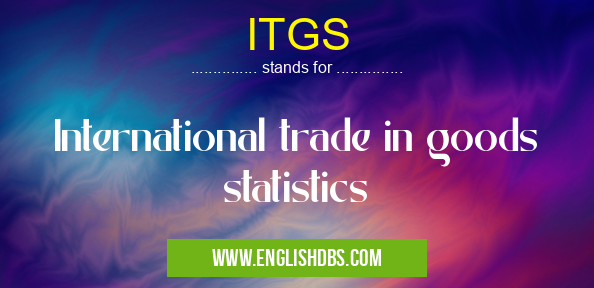What does ITGS mean in STATISTICS
ITGS stands for International Trade in Goods Statistics. It is a global measure of the import and export of goods over time that illustrate economic activity. The data from ITGS are used to analyse international trade patterns, assess the competitiveness of firms, and compare the performance of economies. It is also used for forecasting and policy making. By taking into account both imports and exports, ITGS records are able to provide an accurate indication of a country’s balance of payments (BOP).

ITGS meaning in Statistics in Academic & Science
ITGS mostly used in an acronym Statistics in Category Academic & Science that means International trade in goods statistics
Shorthand: ITGS,
Full Form: International trade in goods statistics
For more information of "International trade in goods statistics", see the section below.
Essential Questions and Answers on International trade in goods statistics in "SCIENCE»STATISTICS"
What is ITGS?
ITGS stands for International Trade in Goods Statistics. It’s a compilation of data and global trade statistics collected by the World Trade Organization (WTO). It provides a comprehensive overview of the trade flows between different countries and their associated value, as well as indicators of trade performance for individual nations.
What type of information does ITGS provide?
ITGS provides a range of data, including average total exports/imports per country, merchandise trade balance, participation in global export and import trends, and indicative proportions of intra-industry and inter-industry trade. Moreover, it provides an insight into the changing international division of labor patterns.
How often is the dataset updated?
The dataset is updated quarterly to reflect new developments in global trade activity
Is all ITGS data publicly available?
Yes, all ITGS data is freely available to view on the WTO's website. Additionally, some organizations may provide access to more in-depth statistical information from specific sources that can be used for research or analysis purposes.
Where can I find forecasts based on the current ITGS data?
Several organizations provide forecasts based on current and historical international trade statistics as reflected by the ITGS dataset. These include private sector entities such as consulting firms and analysts.
What other resources are available to learn more about international trade?
In addition to the extensive resources offered by the WTO, there are numerous other websites that offer useful insight into international trade issues such as economic policies and trading blocks. Examples include The Economist Intelligence Unit (EIU), Global Trade Analysis Project (GTAP) at Purdue University, Panorama Project at Stanford University, The Observatory for Economic Complexity (OEC) at MIT Sloan School of Management.
How can businesses use ITGS data?
Businesses can use international goods statistics to inform strategic decisions such as where best to locate facilities or what markets should be targeted for product expansion or promotion. Moreover, it provides valuable insights into pricing levels across countries.
Are there any limitations when using ITGS data?
There may be certain regional discrepancies within datasets due to changes in national laws or regulations that have not yet been reported, or which may have been inaccurately reported. Therefore it is important that any conclusions drawn from these figures are supported with additional qualitative evidence.
Who can benefit from using this data?
Both public and private sector organisations can benefit from using this data- governments for policy making purposes; businesses for market intelligence; researchers seeking a better understanding of global trends; NGOs shaping their campaigns; chartered accountants providing advice etc.
Final Words:
In conclusion, ITGS stands for International Trade in Goods Statistics – it collects data on imports and exports between countries which helps identify economic trends; it is useful for policymakers and businesses alike since it gives insights into consumer demand patterns as well as enabling comparisons across nations when it comes to labor productivity and exchange rate fluctuations. Also important is its role in helping understand national differences when it comes to regulations affecting trade flows which can ultimately shape the fortunes of businesses hoping to have successful presence abroad.
